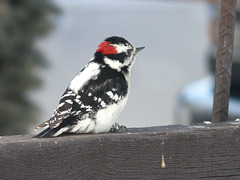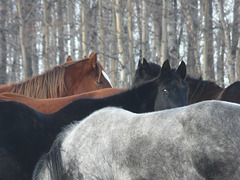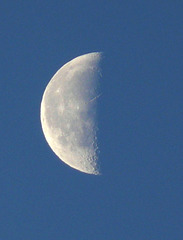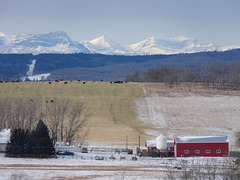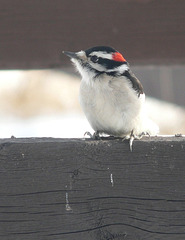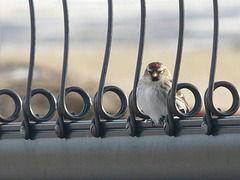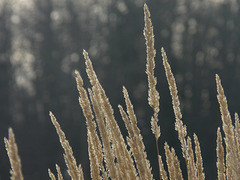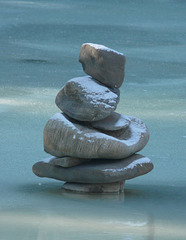Anne Elliott's photos with the keyword: 2007 Christmas Bird Count
Ruffed Grouse
| 04 Jan 2008 |
|
On Monday, 31st December, I took part in the 2007 Christmas Bird Count in the Sheep River/Turner Valley area, south of Calgary. The weather was an absolutely perfect winter's day! On one of our stops for taking a short walk, we were so lucky to have this Ruffed Grouse fly into a tree close to the path. The lighting wasn't the best, but you can still see the rather intricate feather patterns on this bird. A good sighting! These birds are common year-round in Alberta, which doesn't necessarily mean that you will be lucky enough to see one. The Ruffed Grouse is named for the black "ruffs" on the sides of its neck. Displaying males erect these black patches to impress females". From "Birds of Alberta" by Fisher and Acorn.
A bad feather day
| 01 Jan 2008 |
|
Two days ago, I took part in the Cochrane Reserve 2007 Christmas Bird Count. This is north-west of the city. This little male Downy Woodpecker had just visited the feeders at one of the farms/ranches that we stopped at during the day. He looks a little windswept : )
Birds sighted by my small group of 5 people, just in case anyone is interested :
Bald Eagle-2ad/1imm, all feeding on dead coyote.
Rough-legged Hawk-6
Merlin-1 (located 1 km east of Water Valley, 3:50pm)
Rock Pigeon-7
Great Horned Owl-2
Northern Pygmy-Owl-1 (S on R 4.4, about 1 km S of our S boundary-T29.0, at 4:15pm)
Downy Woodpecker-15 (plus 1 at Pygmy-Owl)
Hairy Woodpecker-2 (plus 1 at Pygmy-Owl)
Pileated Woodpecker-1
Blue Jay-2
Black-billed Magpie-49
Common Raven-19 (plus 11 in a group heading west at 4pm.)
Black-capped Chickadee-78
Boreal Chickadee-6
Red-breasted Nuthatch-16
White-breasted Nuthatch-4
Golden-crowned Kinglet-2
European Starling-5
Brown Creeper-1
Bohemian Waxwing-50
White-winged Crossbill-33
Common Redpoll-205
House Sparrow-170
Coyote (alive)-1
White-tailed Deer-13
Mule Deer-8
Non-racial
| 01 Jan 2008 |
|
Yesterday, 31st December, I took part in the 2007 Christmas Bird Count in the Sheep River/Turner Valley area, south of Calgary. The weather was an absolutely perfect winter's day! When I crossed the road to try and photograph three Bald Eagles in a field, feeding on a dead Coyote, I noticed this group of beautiful horses nearby. I liked the different colours all happily together.
A quick moon shot
| 04 Jan 2008 |
|
On Monday 31st December, I took part in the 2007 Christmas Bird Count in the Sheep River/Turner Valley area, south of Calgary. The weather was an absolutely perfect winter's day! When we got out of the car at one of our stops, I glanced up at the moon and thought I'd take a quick shot of it. I was just curious to see how large or small it would look with my fairly new little camera (Panasonic DMC-FZ18). This is a greatly cropped image, but I find it fascinating that even with a little point-and-shoot camera, you can still see some of those interesting craters.
A mix of colours
| 01 Jan 2008 |
|
Yesterday, I was out from 6:10 a.m. to 6:30 p.m., taking part in a Christmas Bird Count on the Cochrane Reserve, north-west of Calgary. Not sure of the exact number of bird species we saw, but it was around 23. Just outside our count area at the end of the day, we saw a beautiful little Northern Pygmy-owl atop a tall Spruce tree. Thanks, Tony, for bringing your scope - what an amazing view we were able to get of this tiny, perfect owl! We called in at various farms and ranches and saw all sorts of things in addition to the birds. The scenery is spectacular! This photo is what you see when you look westwards towards the mountains. The rolling Foothills in the foregoround are just as beautiful in their own way.
On the fence
| 01 Jan 2008 |
|
Yesterday, I was out from 6:10 a.m. to 6:30 p.m., taking part in a Christmas Bird Count on the Cochrane Reserve, north-west of Calgary. Not sure of the exact number of bird species we saw, but it was around 23. We called in at various farms and ranches and saw all sorts of things in addition to the birds. This little male Downy Woodpecker was visiting the feeders at a farm house. They are so small and very cute.
Let me out
| 01 Jan 2008 |
|
These little Common Redpolls are common in Alberta from October to April, but are predictably unpredictable as far as numbers are concerned. This bird was one of a flock that was flying around a farm area south of Calgary. It happened to land on this piece of farm equipment. I would guess that this is a female, as the males tend to have pinkish breasts.
Yesterday, I was out from 6:10 a.m. to 6:30 p.m., taking part in a Christmas Bird Count on the Cochrane Reserve, north-west of Calgary. Not sure of the exact number of bird species we saw, but it was around 23.
Should I spit?
| 01 Jan 2008 |
|
Two days ago, I took part in the Cochrane Reserve 2007 Christmas Bird Count. This is north-west of the city. We also stop and visit various farms/ranches in the area and talk with the owners about what species of birds they see on their land. Lots of very friendly, helpful people! This and another Llama live on one of the farms. Did you know that they have a bad habit of spitting? There are too many Llamas in Alberta now and people find that they are unable to sell them. They are useful, though, in helping to keep Coyotes away from the farm animals.
Sunlit grasses
| 01 Jan 2008 |
|
Thought these grasses looked pretty with the sun shining through them. Saw them on a farm when I took part in the annual 2007 Christmas Bird Count on the Cochrane Reserve, NW of Calgary. This is not a "special" reserve, but is part of the network of country roads and rolling hills east of the mountains, north-west of the city.
Mountain Chickadee
| 01 Jan 2008 |
|
Yesterday, 31st December, I took part in the 2007 Christmas Bird Count in the Sheep River/Turner Valley area, south of Calgary. The weather was an absolutely perfect winter's day! We saw quite a few of these little Mountain Chickadees, which is always a treat. They are uncommon year round in Alberta. This kind of Chickadee has a white eyebrow through the black cap, unlike the Black-capped Chickadee. It has a white cheek, black bib, grey upperparts and tail, and light grey underparts. It breeds at higher elevations and is found more commonly in the mountains, as the name suggests. Usually, though, they move down to the montane forests for the winter months. They are often found together with a group of Black-capped and Boreal Chickadees.
Species seen by my group of 7 people:
Ruffed Grouse-3
Rough-legged Hawk-3
Downy Woodpecker-11
Hairy Woodpecker-2
Pileated Woodpecker-1
Gray Jay-11
Blue Jay-8
Black-billed Magpie-25
Common Raven-22
Black-capped Chickadee-72
Mountain Chickadee-32
Boreal Chickadee-3
Red-breasted Nuthatch-2
White-breasted Nuthatch-1
Dark-eyed Junco-1
Common Redpoll-38
16 species
American Crow-31, off territory, on 332 Av, at Mesa Creek Ranch.
Red Squirrel-1
Coyote-1
White-tailed Deer-4
Deer sp. 13
Inukshuk
| 04 Jan 2008 |
|
On Monday, 31st December, I took part in the 2007 Christmas Bird Count in the Sheep River/Turner Valley area, south of Calgary. The weather was an absolutely perfect winter's day! At one of the farms we stopped at, the owners had built an Inukshuk (pronounced IN-OOK-SHOOK) "art gallery" on the frozen creek that runs along the back of their home.
"Inukshuk (singular), meaning "likeness of a person" in Inuktitut (the Inuit language), is a stone figure made by the Inuit. The plural is inuksuit. The Inuit make inuksuit in different forms and for different purposes: to show directions to travellers, to warn of impending danger, to mark a place of respect, or to act as helpers in the hunting of caribou. Similar stone figures were made all over the world in ancient times, but the Arctic is one of the few places where they still stand. An inukshuk can be small or large, a single rock, several rocks balanced on each other, round boulders or flat. Inuit tradition forbids the destruction of inuksuit.
Inukshuk in the form of human beings, called inunnguaq, seem to have been a recent development, perhaps only appearing after the arrival of European whalers in the 19th century. One of the most important types of inuksuit are those that helped in the caribou hunt. These are usually built with 2 or 3 rocks piled up and placed in converging lines along the migration route of the herd. The Inuit placed arctic heather among the rocks to simulate human hair. The figures were intended to spook the caribou and stampede them towards the places where the hunters hid.
An open leg on an inukshuk found near water or a coastline may point to an open channel for navigation. If an inukshuk is in open land, a leg or arm might suggest a direction. Inuksuit placed near a lake might show that fish can be found in the lake at the same distance the figure is placed from the shoreline. Some inuksuit were built out of respect for a beloved person and are seen as memorials." From www.thecanadianencyclopedia.com .
Mountain Chickadee
| 04 Jan 2008 |
|
On Monday 31st December, I took part in the 2007 Christmas Bird Count in the Sheep River/Turner Valley area, south of Calgary. The weather was an absolutely perfect winter's day! We saw quite a few of these little Mountain Chickadees, which is always a treat. They are uncommon year round in Alberta. This kind of Chickadee has a white eyebrow through the black cap, unlike the Black-capped Chickadee. It has a white cheek, black bib, grey upperparts and tail, and light grey underparts. It breeds at higher elevations and is found more commonly in the mountains, as the name suggests. Usually, though, they move down to the montane forests for the winter months. They are often found together with a group of Black-capped and Boreal Chickadees.
Ruffed Grouse
| 05 Jan 2008 |
|
On Monday, 31st December, I took part in the 2007 Christmas Bird Count in the Sheep River/Turner Valley area, south of Calgary. The weather was an absolutely perfect winter's day! On one of our stops for taking a short walk, we were so lucky to have this Ruffed Grouse fly into a tree close to the path. The lighting wasn't the best, but you can still see the rather intricate feather patterns on this bird. A good sighting! These birds are common year-round in Alberta, which doesn't necessarily mean that you will be lucky enough to see one. The Ruffed Grouse is named for the black "ruffs" on the sides of its neck. Displaying males erect these black patches to impress females". From "Birds of Alberta" by Fisher and Acorn.
Mountain Chickadee
| 08 Jan 2008 |
|
A little Mountain Chickadee, seen when I took part in the Sheep River/Turner Valley Christmas Bird Count on 31st December 2007.
Jump to top
RSS feed- Anne Elliott's latest photos with "2007 Christmas Bird Count" - Photos
- ipernity © 2007-2025
- Help & Contact
|
Club news
|
About ipernity
|
History |
ipernity Club & Prices |
Guide of good conduct
Donate | Group guidelines | Privacy policy | Terms of use | Statutes | In memoria -
Facebook
Twitter


